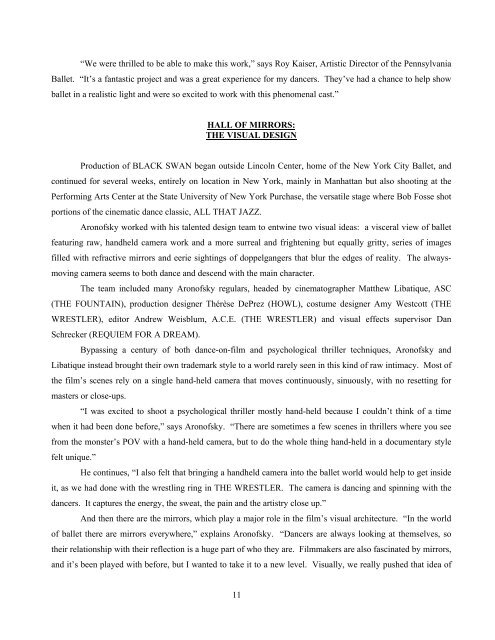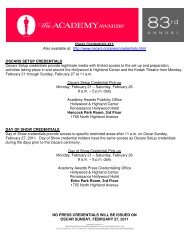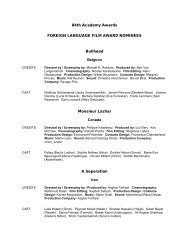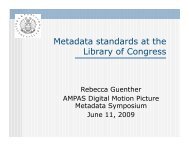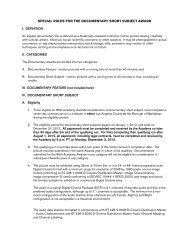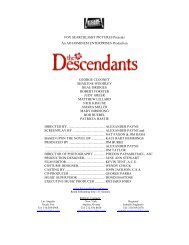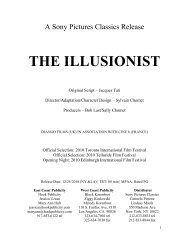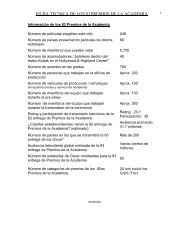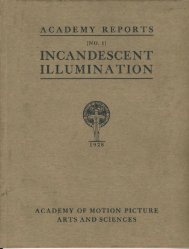FOX SEARCHLIGHT PICTURES Presents In association with ...
FOX SEARCHLIGHT PICTURES Presents In association with ...
FOX SEARCHLIGHT PICTURES Presents In association with ...
Create successful ePaper yourself
Turn your PDF publications into a flip-book with our unique Google optimized e-Paper software.
“We were thrilled to be able to make this work,” says Roy Kaiser, Artistic Director of the Pennsylvania<br />
Ballet. “It’s a fantastic project and was a great experience for my dancers. They’ve had a chance to help show<br />
ballet in a realistic light and were so excited to work <strong>with</strong> this phenomenal cast.”<br />
HALL OF MIRRORS:<br />
THE VISUAL DESIGN<br />
Production of BLACK SWAN began outside Lincoln Center, home of the New York City Ballet, and<br />
continued for several weeks, entirely on location in New York, mainly in Manhattan but also shooting at the<br />
Performing Arts Center at the State University of New York Purchase, the versatile stage where Bob Fosse shot<br />
portions of the cinematic dance classic, ALL THAT JAZZ.<br />
Aronofsky worked <strong>with</strong> his talented design team to entwine two visual ideas: a visceral view of ballet<br />
featuring raw, handheld camera work and a more surreal and frightening but equally gritty, series of images<br />
filled <strong>with</strong> refractive mirrors and eerie sightings of doppelgangers that blur the edges of reality. The alwaysmoving<br />
camera seems to both dance and descend <strong>with</strong> the main character.<br />
The team included many Aronofsky regulars, headed by cinematographer Matthew Libatique, ASC<br />
(THE FOUNTAIN), production designer Thérèse DePrez (HOWL), costume designer Amy Westcott (THE<br />
WRESTLER), editor Andrew Weisblum, A.C.E. (THE WRESTLER) and visual effects supervisor Dan<br />
Schrecker (REQUIEM FOR A DREAM).<br />
Bypassing a century of both dance-on-film and psychological thriller techniques, Aronofsky and<br />
Libatique instead brought their own trademark style to a world rarely seen in this kind of raw intimacy. Most of<br />
the film’s scenes rely on a single hand-held camera that moves continuously, sinuously, <strong>with</strong> no resetting for<br />
masters or close-ups.<br />
“I was excited to shoot a psychological thriller mostly hand-held because I couldn’t think of a time<br />
when it had been done before,” says Aronofsky. “There are sometimes a few scenes in thrillers where you see<br />
from the monster’s POV <strong>with</strong> a hand-held camera, but to do the whole thing hand-held in a documentary style<br />
felt unique.”<br />
He continues, “I also felt that bringing a handheld camera into the ballet world would help to get inside<br />
it, as we had done <strong>with</strong> the wrestling ring in THE WRESTLER. The camera is dancing and spinning <strong>with</strong> the<br />
dancers. It captures the energy, the sweat, the pain and the artistry close up.”<br />
And then there are the mirrors, which play a major role in the film’s visual architecture. “<strong>In</strong> the world<br />
of ballet there are mirrors everywhere,” explains Aronofsky. “Dancers are always looking at themselves, so<br />
their relationship <strong>with</strong> their reflection is a huge part of who they are. Filmmakers are also fascinated by mirrors,<br />
and it’s been played <strong>with</strong> before, but I wanted to take it to a new level. Visually, we really pushed that idea of<br />
11


